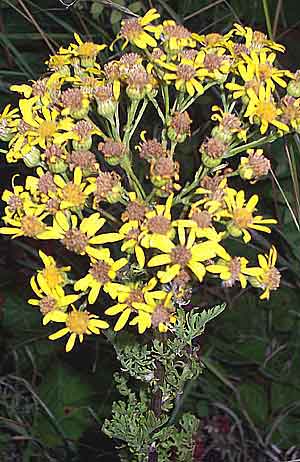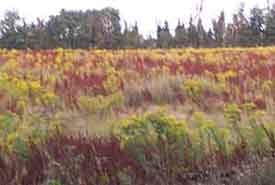The Danger of Ragwort Poisoning for Horses -
A Slow and Painful Death
 Ragwort
poisoning is one of the most common causes of plant poisoning
in equines; with young horses and ponies
most at risk.
Ragwort
poisoning is one of the most common causes of plant poisoning
in equines; with young horses and ponies
most at risk.
It destroys the horse's liver, leading to a slow and painful death. Most horses affected by ragwort poisoning die after suffering for periods varying from a week to several months.
Unfortunately once symptoms of ragwort poisoning have appeared in a horse or pony very little can be done to save it and, sadly, it will usually die.
A horse or pony can be poisoned by ragwort without even having any plants in their grazing area. Seeds from ragwort plants in neighbouring paddocks and fields can be blown across and contaminate an area apparently free from ragwort. A horse or pony can inhale or eat these seeds and become affected by cumulative poisoning.
Although Ragwort flowers are only seen during the from May to October, the effects of poisoning can occur at any time of the year. The plant is most poisonous during its first year of growth when it appears as a dense rosette of leaves , but with no flowers.
The poisonous effect of ragwort on a horse is cumulative - a small amount of the plant eaten over a long time is just as dangerous as a lot being eaten in just a few days.
Symptoms of poisoning do not always appear immediatley after a horse or pony has eaten a large amount of ragwort. It may take as long as 4 weeks to 6 months for the equine liver disease to develop.
Different horses have different reactions to to the toxins in the plant.
Poorly managed grazing for horses is particularly likely to suffer ragwort infestations. Closely growing grass restricts the growth of ragwort, whilst overgrazed paddocks leave patches of soil that leave perfect conditions for ragwort seeds to germinate.
Horses that eat ragwort as 5% or more of their total daily diet for more than 20 consecutive days can be expected to die within 6 months.
It is believed that some equines get to like the bitter taste of ragwort and may choose to eat it even when there is good grazing available.
Hay is a common source of ragwort poisoning. Unfortunately when ragwort is dried it loses its bitter taste and horses are no longer able to detect it. So any hay, haylage or even chaff which contains the weed will be readily eaten. It is really important to check bales of hay for ragwort as the toxins are not destroyed whent he plant dies - but it may not always be easy to recognise ragwort when it is dried and fragmented.
Why you buy hay it may be possible to check the source, ask what method of weed control was used and maybe even visit the hayfield that the hay was cut from.
There are 2 acts of goverment in the UK concerning the control of ragwort.
When ragwort appears on agricultural or equestrian property the landowner is legally required to treat and clear it. DEFRA may take action where this is not done.
|
|
HORSE CARE ADVICE AND EQUESTRIAN ARTICLES
Horse Insurance Advice | Salt Blocks for Horses | Fitting a Lungeing Cavesson | Supplements for Veteran Horses | Homeopathic Treatment of Equine Sweat Bumps | Arthritis Supplements for Horses |Symptoms of Colic in Horses | Kent Tack Shops | Benefits of Equine Glucosamine Supplements | Horse Feed Storage | Anaemic Horse |Capped Hocks| Feeding Overweight Horse | Horse Dentistry | Growing Carrots |Ragwort poisoning - one of the most common causes of plant poisoning in equines,
destroying the liver. Young horses and ponies most at risk. For prevention grazing
should be treated with weedkiller to destroy ragwort

